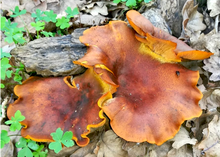| Omphalotus olearius | |
|---|---|

| |
| Scientific classification | |
| Domain: | Eukaryota |
| Kingdom: | Fungi |
| Division: | Basidiomycota |
| Class: | Agaricomycetes |
| Order: | Agaricales |
| Family: | Omphalotaceae |
| Genus: | Omphalotus |
| Species: | O. olearius
|
| Binomial name | |
| Omphalotus olearius | |
| Synonyms[1] | |

Omphalotus olearius,[2] commonly known as the jack-o'-lantern mushroom, is a poisonous orange gilled mushroom that to an untrained eye appears similar to some chanterelles. It is notable for its bioluminescent properties. It is found in woodland areas in Europe, where it grows on decaying stumps, on buried roots or at the base of hardwood trees. It has also been reported from the Western Cape Province, South Africa. A similar, but phylogenetically distinct[3] species found in eastern North America is Omphalotus illudens.
Unlike chanterelles, Omphalotus olearius and other Omphalotus species contain the toxin illudin S, and are poisonous to humans. While not lethal, consuming this mushroom leads to very severe cramps, vomiting, and diarrhea.
YouTube Encyclopedic
-
1/3Views:147 2655 65740 244
-
Chanterelle Look Alikes - Toxic Jack O' Lantern Mushroom Identification
-
Poisons wild Jack O Lantern, mushroom
-
Poisonous Wild Mushrooms : "Jackolantern"
Transcription
Description
The jack-o'-lantern mushroom is orange. Its bioluminescence, a blue-green color, can be observed in fresh specimens in low light conditions once the eye becomes dark-adapted. The whole mushroom does not glow—only the gills do so. This is due to an enzyme called luciferase, acting upon a compound called luciferin, leading to the emission of light much as fireflies do when glowing.[4]
| Omphalotus olearius | |
|---|---|
| Gills on hymenium | |
| Cap is infundibuliform | |
| Hymenium is decurrent | |
| Stipe is bare | |
| Spore print is yellow | |
| Ecology is saprotrophic | |
| Edibility is poisonous | |
Similar species
Unlike chanterelles, jack-o'-lantern mushrooms have true, sharp, non-forking gills; this is possibly the simplest trait for distinguishing between the two. Furthermore, if the jack-o'-lantern's stem is peeled, the inside is orange, while the chanterelle is paler inside the stem.
Omphalotus illudens of eastern North America, and the Western jack-o'-lantern mushroom Omphalotus olivascens common in southern to central California, are both poisonous. The similarly poisonous mushroom Tsukiyotake (Omphalotus japonicus, formerly known as Lampteromyces japonicus, found in Japan and eastern Asia, is also bioluminescent and contains the same poison, illudin.[3]
See also
Gallery
-
Bioluminescent gills
-
Close up of gills
-
-
-
-
-
References
- ^ "Synonymy: Omphalotus olearius (DC.) Singer". Species Fungorum. CAB International. Retrieved 2015-09-24.
- ^ Singer R (1948) In: Pap. Mich. Acad. Sci. 32: 133 ('1946').
- ^ a b Kirchmair M, Morandell S, Stolz D, Pöder R, Sturmbauer C (2004). "Phylogeny of the genus Omphalotus based on nuclear ribosomal DNA-sequences" (PDF). Mycologia. 96 (6): 1253–60. doi:10.2307/3762142. JSTOR 3762142. PMID 21148949. Retrieved 2010-05-26.
- ^ Oliveira AG, Desjardin DE, Perry BA, Stevani CV (2012). "Evidence that a single bioluminescent system is shared by all known bioluminescent fungal lineages". Photochemical and Photobiological Sciences. 11 (5): 848–852. doi:10.1039/c2pp25032b. PMID 22495263.
External links
- AmericanMushrooms.com: Jack O'Lantern Mushroom
- Tom Volk's Fungus of the Month October 1997
- Iowa State University Horticulture & Home Pest News







